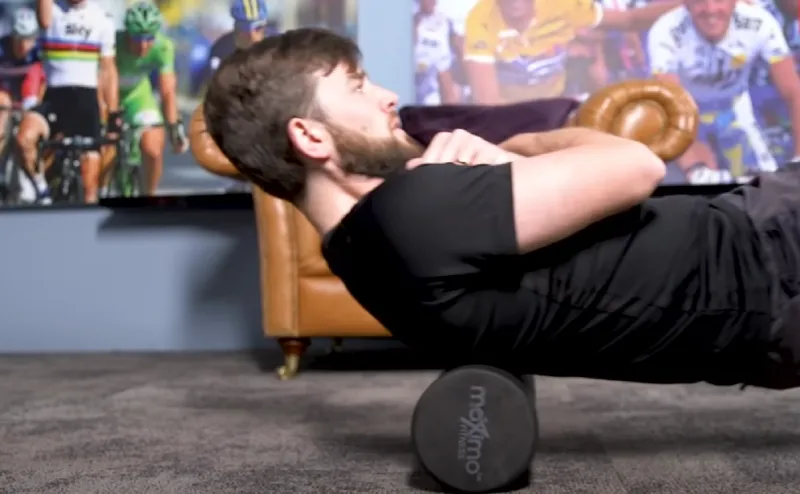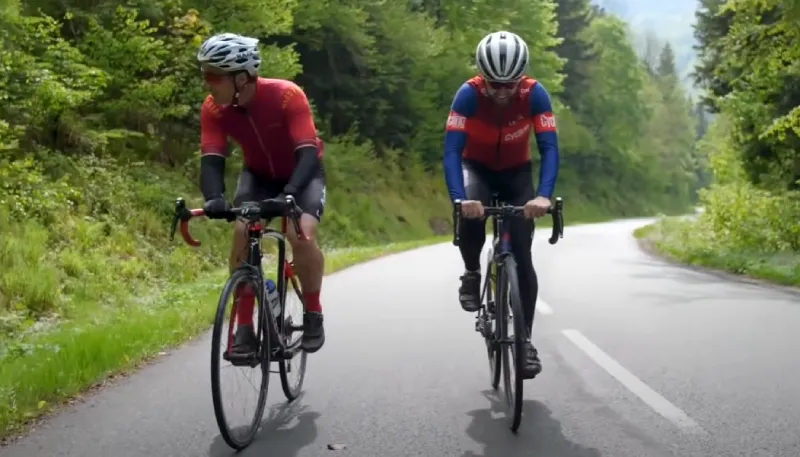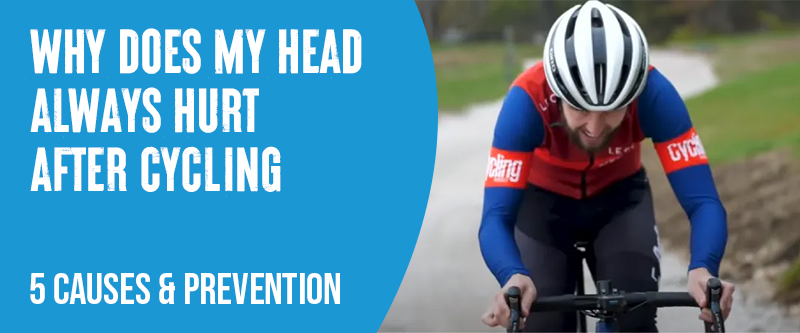Headaches arise when an unidentified mechanism triggers nerves in your body, transmitting pain signals to the brain. A prolonged four-day headache may indicate a neurological condition like migraine, a headache disorder, or an injury.
Strenuous exercise, dehydration, or low blood sugar levels can hurt your head after cycling. You can prevent headaches while cycling by eating a nutritious snack before and after your workout. Persistent post-cycling headaches should be monitored because they may indicate a more serious underlying problem.
This blog post explores cycling and hurting heads to uncover potential causes and preventative measures for this common issue.
Why Does My Head Always Hurt After Cycling: 5 Reasons

Welcome to our detailed exploration of why your head might hurt after cycling. You don’t want to be pedaling towards pain as you pedal your way to fitness. Let us guide you through the causes and solutions for your post-cycling headaches.
Dehydration
Keeping hydrated is key to a safe and pleasant cycling journey. Inadequate water intake may result in dehydration, leading to headaches and other related complications.
Importance of Staying Hydrated During Long Rides
When you cycle, your body loses water through sweat. This loss needs to be replaced to keep your body functioning well.
- Maintains Energy Levels: Water helps transport nutrients that give you energy.
- Regulates Body Temperature: Staying hydrated keeps you cool and prevents overheating.
- Prevents Cramps: Proper hydration helps muscles work smoothly and reduces the chance of cramps.
Dehydration Signs and Effects
During long rides, it’s easy to become dehydrated. Recognizing the signs early can help you take action for hurting your head.
- Dry Mouth: Feeling like your mouth is sticky or dry.
- Dark Urine: Urine darker than usual can be a sign of dehydration.
- Fatigue: Feeling unusually tired or weak can mean not getting enough water.
- Headaches: Insufficient water consumption may cause headaches, making it hard to focus and enjoy your ride.
Tips for Staying Hydrated
Here are some simple tips to keep your hydration levels up:
- Drink Regularly: Take small sips of water every 15-20 minutes, even if you don’t feel thirsty.
- Use Electrolyte Drinks: Sports drinks can help replace lost salts and minerals.
- Monitor Your Urine: Light-colored urine is a good sign that you’re well-hydrated.
- Carry Extra Water: Always bring more water than you need, especially on long rides.
Staying hydrated can prevent dehydration and avoid headaches. Drink plenty of water before, during, and after your rides to keep your body happy and healthy.
Neck Strain and Bike Position

Riding a bike should be painless, but improper setups can lead to neck strain and headaches. Understanding how your bike position affects your body can help you ride pain-free.
Incorrect bike positioning causes neck and back strain
When your bike isn’t set up correctly, your neck muscles may work harder than they should.
- Forward Lean: Too much forward lean can strain your neck and shoulders, compromising your vision.
- Handlebar Height: If your handlebars are too low or too high, it can cause tension in your neck.
- Seat Position: A seat that’s too high or too low can make reaching uncomfortably difficult, leading to neck pain.
Importance of Correct Helmet Fit and Posture
Wearing a helmet and maintaining good posture is crucial for preventing neck strain and headaches.
Helmet Fit: A helmet that fits well, protects your head and doesn’t add extra weight or pressure to your neck.
- Ensure the helmet sits level on your head.
- Adjust the straps so they’re snug but not too tight.
Good Posture: Straightening your back and relaxing your shoulders can reduce neck strain.
- Avoid slouching or hunching over the handlebars.
- Slightly bend your elbows to absorb shocks from the road.
Tips for Bike Setup Adjustments to Prevent Strain
Making a few adjustments to your bike can help prevent neck strain and headaches.
Handlebars: Make sure your handlebars are at a comfortable height.
- Your hands should easily reach the brake levers without stretching.
- Consider using ergonomic grips for added comfort.
Saddle Height: Set the saddle height so your legs bend slightly at the knees when the pedal is at its lowest point.
- Use a level to ensure the seat is horizontal.
Bike Fit: You have to consider getting your bike fitted professionally.
- A bike fit expert can measure and adjust your bike to match your body.
By paying attention to your bike setup and posture, you can avoid neck strain and headaches, making your cycling experience much more enjoyable.
Exercise-Related Head Hurt

Exertional headaches are another common reason for head hurt after cycling. These headaches happen when you push your body too hard during exercise.
Definition and Causes of Exertional Headaches
Intense physical activity can cause exertional headaches.
- Definition: A headache that occurs during or after exercise.
- Causes: Strenuous activities like cycling can increase blood pressure in your head, leading to pain.
Headaches Associated with Rapid Exercise
Starting an intense workout without proper preparation can cause exertional headaches.
- Lack of Warm-Up: Skipping a warm-up can shock your body and lead to headaches.
- Sudden Intensity: Going from no activity to high-intensity exercise can strain your blood vessels and muscles, causing pain.
- Overexertion: Pushing yourself too hard, especially if you’re not used to it, can trigger headaches.
Strategies for Gradually Increasing Workout Intensity
To avoid exertional headaches, gradually building up your workout intensity gradually is essential.
Warm-Up: Begin every ride with a gentle warm-up to prepare your body.
- Spend at least 10 minutes doing light activity before increasing intensity.
Pace Yourself: Slowly increase the length and intensity of your rides.
- Add a few more minutes or miles each week.
Stay Consistent: Regular exercise helps your body adapt better over time.
- Aim for regular, moderate exercise rather than occasional intense sessions.
Cool Down: Finish your rides with a cool-down to help your body recover.
- Spend 5-10 minutes cycling slowly and stretching your muscles.
Understanding and avoiding exertional headaches can make cycling a more pleasant experience. Remember to build up your workouts gradually and listen to your body to prevent these painful headaches.
Muscle Tension

Another common reason for headaches after cycling is muscle tension. Tight muscles, especially in the head, neck, and scalp, can lead to pain and discomfort.
Role of Muscle Tension in Hurt Head
Tight muscles can create pressure and pain, leading to headaches.
- Head Muscles: Tension in the scalp muscles can cause a squeezing sensation.
- Neck Muscles: Stiff neck muscles can radiate pain to your head.
- Shoulders: Tight shoulders can contribute to neck strain and headaches.
Importance of Stretching and Cooling Down After Rides
Stretching and cooling down can help relax your muscles and prevent headaches.
Stretching: Helps increase blood flow and reduce tension.
- Focus on the neck, shoulders, and back.
- Hold each stretch for 15-30 seconds.
Cooling Down: Gradually lowers your heart rate and relaxes your muscles.
- Spend 10-15 minutes cycling slowly.
- Follow up with gentle stretching.
Techniques for Managing Muscle Tension
Lacrosse balls and foam rollers can help ease muscle tightness.
Foam Rolling: Helps massage and relax large muscle groups.
- Roll over tight areas for 1-2 minutes.
- Focus on the back, thighs, and calves.
Lacrosse Ball: Targets smaller, hard-to-reach spots.
- Place the ball between your body and a wall or floor.
- Gently roll over tight areas, especially in the neck and shoulders.
Cycling With Low Blood Sugar

Low blood sugar is called hypoglycemia, which causes head hurting, among other symptoms. Here’s how it affects your head:
Mechanism Behind Low Blood Sugar and Headaches
- Brain’s Energy Supply: The brain relies heavily on glucose for energy. When blood sugar drops, the brain doesn’t receive enough glucose, impairing its function and leading to a hurt head.
- Release of Stress Hormones: Low blood sugar triggers adrenaline and cortisol release. These hormones are intended to raise blood sugar levels but can cause symptoms such as a hurting head, sweating, and anxiety.
- Vasodilation: Fluctuations in blood sugar levels can cause blood vessels in the brain to expand (vasodilation) or contract, leading to headaches. This is similar to what happens with migraines.
Symptoms Accompanying Hypoglycemic Headaches
- Dizziness.
- Confusion.
- Sweating.
- Shaking.
- Irritability.
- Weakness.
- Blurred vision.
Prevention and Management
- Regular Meals: Regular meals and snacks that include complex carbohydrates, proteins, and fats can help maintain stable blood sugar levels.
- Monitor Blood Sugar: Monitoring blood sugar can help prevent significant drops in those with diabetes or hypoglycemia.
- Quick Carbohydrates: If you feel a headache due to low blood sugar, consuming quick-acting carbohydrates like fruit juice, glucose tablets, or candy can help raise blood sugar levels quickly.
- Medical Advice: If you frequently experience hypoglycemic episodes or related headaches, seek medical attention.
Conclusion
Cycling should be a refreshing and stress-relieving adventure, not one that leaves you with a pounding headache. Avoid the dreaded post-cycling headache by identifying potential triggers such as dehydration and neck strain from improper bike positioning.
Exercise-induced headaches, muscle tension, and external factors like heat and altitude can also contribute. So, get ready, stay hydrated, mind your posture, gradually boost your workout intensity, stretch properly, and be mindful of external conditions.
FAQs
What Causes Sharp Pain in The Head?
Sharp head pain is often caused by primary headache disorders such as migraines or cluster headaches, which are not life-threatening but can disrupt daily life. In rarer cases, conditions like strokes or aneurysms may be the underlying cause of such pain.
Why Does My Head Hurt When I Press On It?
Pressing on your head may cause pain due to tension headaches or migraines, common conditions. These types of headaches typically respond well to treatment. However, persistent or severe head pressure could indicate a more serious underlying condition.


